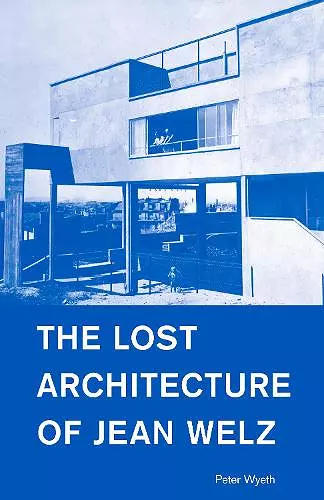The Lost Architecture of Jean Welz
Format:Paperback
Publisher:DoppelHouse Press
Published:11th Aug '22
Should be back in stock very soon

Endorsements by leading architectural scholars
International Print and Broadcast Campaign
Social Media Campaign
Targeted outreach to art and architecture bookstores and libraries
Unique cover and book design appeals to art magazines and bookstores
Promotion through the Society of Architectural Historians/Southern California Chapter
DRCs available through Edelweiss
ARCs available upon request
A deserted Paris house holds the mystery of a brilliant Viennese modernist who worked alongside Le Corbusier and Adolf Loos before vanishing.
Wyeth takes readers on a deeply personal and revelatory journey. This research process, which readers experience vicariously, makes Wyeth’s prose exhilarating as tiny details become breakthroughs of grand proportions. […] For late architect and painter Jean Welz, designs should reflect one’s aesthetic and political commitments. This narrative will resonate with anyone interested in the politics of architecture, or the pursuit of knowledge at large.
—Hyperallergic "BEST ART BOOKS OF 2022"
Welz’s having been “lost” is indeed a travesty of architectural history to which the book serves as a welcome antidote.
—Artforum
A leading painter still highly regarded in South Africa, Jean Welz's prior architectural career has been virtually unknown until a string of discoveries unfolded for author and filmmaker Peter Wyeth, allowing him to narrate this amazing true tale of genius. Trained in ultra-sophisticated, but conservative Vienna, Welz was sent to Paris for the 1925 Art Deco exhibition by his influential employer, renowned architect Josef Hoffmann. There he met preeminent modern architects Le Corbusier and Adolf Loos. The latter employed him to assist in building a house for the founder of Dada, Tristan Tzara. They all mixed in avant-garde circles at the Dôme Café in Montparnasse along with Welz’s classmate from Vienna, later Chicago-based architect Gabriel Guevrekian; Welz’s future employer Raymond Fischer, whose archive was mostly destroyed by Nazis; and photographer André Kertész.
Through Welz’s South African family archive, author Wyeth retrieves stories, letters, portfolios, and photographs generations after Welz’s death that unravel his heroic designs, his stunning built critique of Corbusier’s “Five Points of Architecture,” a gravestone for Marx’s daughter, and the many ways that Welz disappeared amongst his collaborators, intentionally and not. This account of why Jean Welz did not become a famous name in architecture takes us through his brother’s Nazi-art-dealings, illness, betrayal, emigration, and an uncompromising artist’s vision at the same time sifting through significant, literally-concrete evidence of Welz’s built projects and visionary designs.
Peter Wyeth has masterfully charted architect Jean Welz’s work and trajectory from Vienna to Paris and South Africa, as well as his contacts with remarkable clients, colleagues, artists and photographers. He has at last paid homage to his striking designs, such as the Zilveli villa built in Paris in 1933, which deserves to be inscribed in the narrative of European Modernism. —Jean-Louis Cohen, Sheldon H. Solow Professor in the History of Architecture, Institute of Fine Arts, New York University
Known, if at all, as a much-admired painter in South Africa in the mid-twentieth century, Jean Welz's complex architecture career is now marvelously pieced together for the first time. —Robin Middleton, professor Emeritus, Department of Art History and Archaeology, Columbia University
Peter Wyeth's really marvelous book uncovers a highly gifted modernist unknown to the public, whose architecture absorbed the most important ideas of Loos and Le Corbusier. As a filmmaker, Wyeth combines a sharp analysis of Europe's artistic movements between the two wars with refreshing personal insights to create a fascinating portrait that is both fluid and easy to read. —Burkhardt Rukschcio, author of Adolf Loos: Leben und Werk
One of the last testimonies of modernism in intramural Paris is the the Maison Zilveli by the Viennese architect Jean Welz, near Adolf Loos and the Roche du Corbusier house. […] British filmmaker Peter Wyeth, very involved in the preservation of the house, explains that “it is very rare to have a modernist house that has remained unchanged: it is a real case study.” —Le Journal des Arts
Jean Welz and his architecture do exist! Let's hope his architecture survives and defies ignorance. — Richard Klein, architect, professor, chair of docomomo France
Peter Wyeth is to be commended not only for rediscovering Jean Welz and his work but also for reconstructing the network of interactions, innovations and transmission of ideas that constitute the real history of architecture. —Tim Benton, professor and author of The Villas of Le Corbusier and Pierre Jeanneret 1920–1930
This vivid and remarkable excavation of the life and work of the Viennese-born architect Jean Welz is a splendid contribution to the history of modernism. Welz was closely connected with two of the titans of the age, Le Corbusier and Adolf Loos, but, even more, he was an excellent architect, whose work was sensitive, beautiful, and inventive. Wyeth tells his story well, bringing known aspects of the tale of modern architecture into sharper focus, while adding much that is new. —Christopher Long, professor, University of Texas at Austin and author of The New Space: Movement and Experience in Viennese Modern Architecture
ISBN: 9781954600003
Dimensions: unknown
Weight: unknown
368 pages